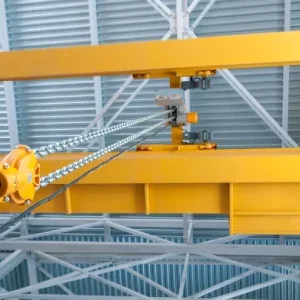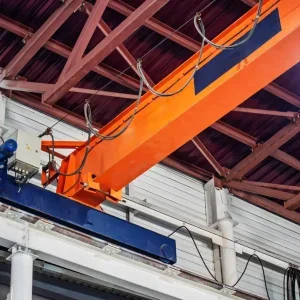In the last issue of Hoist, this column stressed the importance of regular in-service inspection of lifting equipment and dealt in detail with chain slings. This month, it provides practical guidance on how in-service inspections should be performed on wire rope slings, flat woven webbing slings and roundslings. As with chain slings, all these product groups are vulnerable to accidental damage every time they are used, even when lifting well within their safe working load. A misjudged angle, a slight slippage as the tension comes on, or an unprotected sharp corner of the load can all result in accidental damage.
It therefore emphasises the need for the slinger or operator to make basic safety checks at least on a daily basis but preferably each time the sling in question is used. In this respect it should be stressed that equipment can be damaged or deteriorate as quickly in storage as it can in active service, particularly if the conditions are less than perfect. The basic rule is simple: just because a piece of equipment went into storage in a sound condition, it doesn’t necessarily follow that it will emerge in a similar state. Check it before use!
To briefly recap, before starting the inspection, ensure that there is adequate lighting and that the sling is sufficiently clean to enable obvious defects to be identified. Be methodical and follow a regular routine.
Wire rope slings
(1) The master link. Master links used for wire rope slings usually have even larger internal dimensions than those for chain slings in order to accommodate thimbled rope terminations. Remember that any sign of collapse and elongation is an indication of overload. Check also for distortion in other directions. Otherwise check it the same as for a chain sling.
(2) The sling eyes and splice. There are several variations, the simplest being a ferrule secured “soft eye”. Check for signs of movement at the ferrule and cracking or other damage to the ferrule. Soft eyes used on too large a connection can put an unacceptable opening force onto the ferrule. Soft eyes used with too small a connection will show signs of permanent distortion and core protrusion. Usually if the sling has terminal fittings, the eye will be thimbled. Look out for distortion of the thimble which indicates overload and ensure that the terminal fittings articulate easily in the thimble.
Less common but still used in some applications are hand spliced eyes. Again look for any signs that the splice has started to slip, such as a slack fitting thimble or a thimble starting to rotate. Check also that the serving over the tails of the splice is intact and secure, bearing in mind the risk of hand injury from exposed wire ends.
(3) The rope. Look for broken or cut wires. The cause of broken wires in a sling is different to that of a running rope and the rejection criteria are therefore different. From a strength point of view, a few broken wires can be tolerated if they are distributed over a length of several rope diameters. However, breaks are often caused by use over sharp edges and several wires in the same place can be affected. This is not acceptable. Also consider the risk of injury from even a single broken wire to anyone handling the sling.
Check for kinks. Some permanent setting due to previous use around a load is acceptable, particularly if it is a single use sling dedicated to that load. However, check carefully for other signs of local damage. Severely kinked slings should not be used.
Wire rope slings can also be damaged in several other ways. Surface corrosion is easily visible but internal corrosion may be less obvious. A local increase in diameter is one indication and, when flexing the rope, it may feel unduly stiff or even produce rust particles. Excessive heat can soften the rope and reduce very considerably the tensile strength of the wires. Look for signs of colour change.
(4) The lower terminal fittings. Generally these are similar fittings to those used on chain slings and should be checked for the same types of defects, i.e. distortion, notches and missing or ineffective latches. Hooks for use with wire rope usually have a bigger eye to accept a thimbled rope, so check that any such connection articulates freely.
Flat woven webbing slings
(1) Metal terminal fittings. Flat woven webbing slings are usually terminated with soft eyes but can have metal terminal fittings similar to chain or wire rope slings. However, one important difference is the shape of those fittings where they connect to the webbing. Because webbing is essentially a broad thin medium, the load must be distributed as uniformly as possible across its width and not concentrated on the edge. The fittings must therefore be shaped accordingly. Some fittings can be detached from the webbing and substitutes installed instead; as well as the usual checks on the condition of any fittings, check that those fitted have a shape compatible with the webbing.
(2) The sewn webbing component. Check the condition of the stitching and do not use the sling if there is any sign of it pulling undone. If an eye has been used on too large a connection it may have started to tear the stitching open from the base of the eye. Next check the condition of the webbing for signs of wear or cutting. In particular, never use a sling if there is any damage to the edge of the webbing. Also look for any hard or shiny surface which indicates heat damage. Heat damage can be caused by friction if the sling is used in choke hitch and there is slippage under load. Webbing slings are often fitted with wear sleeves or pads which protect the load bearing webbing. Damage to these wear sleeves or pads is acceptable, provided the load bearing webbing is not affected.
Webbing slings are made of synthetic fibre and can also be damaged by chemical attack, direct heat and prolonged exposure to the sun. If they are used in an environment where that is possible then additional precautions beyond what can be explained easily in this article will be required. However, if necessary for removing everyday dirt, webbing slings should be washed with clean water and allowed to dry naturally.
Roundslings
Although roundslings can be made with metal terminal fittings, the vast majority are not. Essentially the load bearing part of a roundsling is the core within the sleeve. So far as mechanical damage goes, provided the sleeve is intact and the core not exposed, then the sling will be fit for service. However, being made of synthetic fibre, roundslings can be damaged by heat and chemicals the same as webbing slings. The same precautions should therefore be taken, with checks made to the surface of the sleeve for signs of heat or chemical attack which may have penetrated to the core.
The above identifies the main defects which can be found easily during a relatively quick in-service inspection of these three types of sling. Check also that the sling identification and safe working load markings are present and legible. Finally, remember that the in-service inspection is in addition to and not a substitute for the higher level, more rigorous inspection regime described in the last issue of Hoist and known in the UK as a thorough examination.






